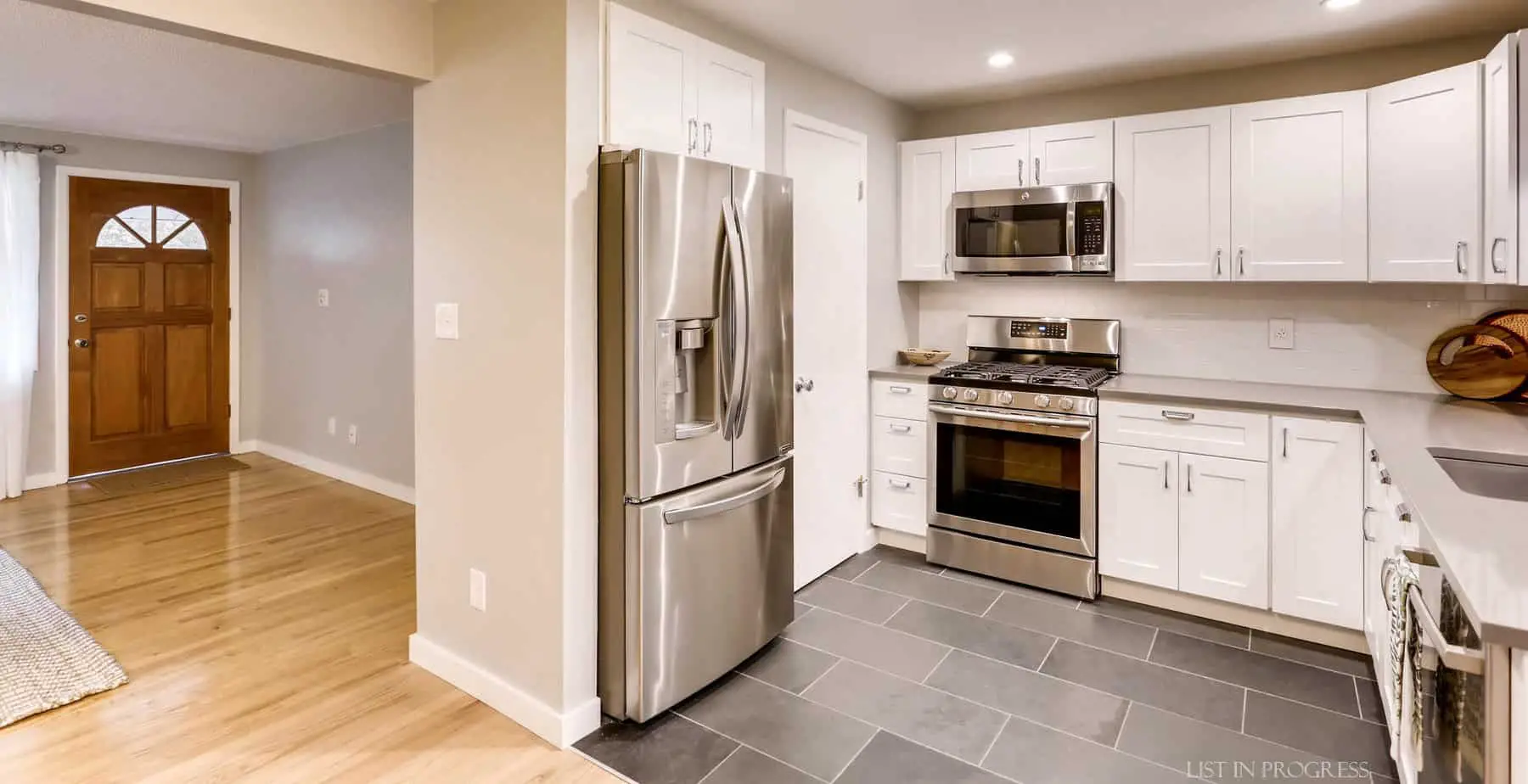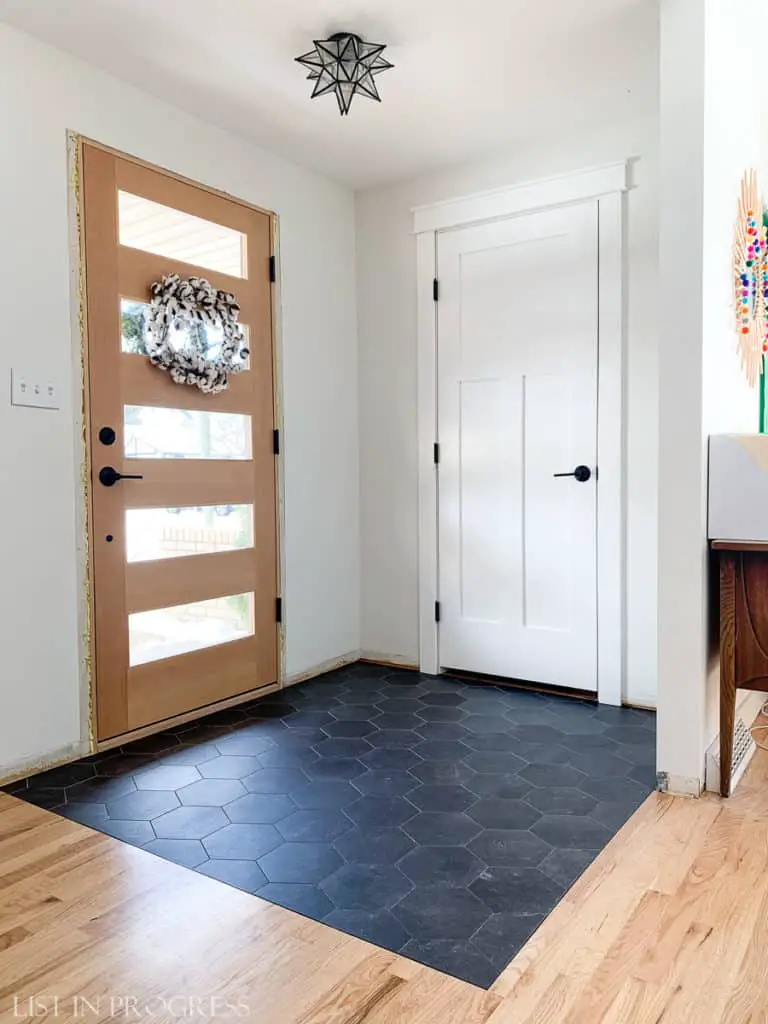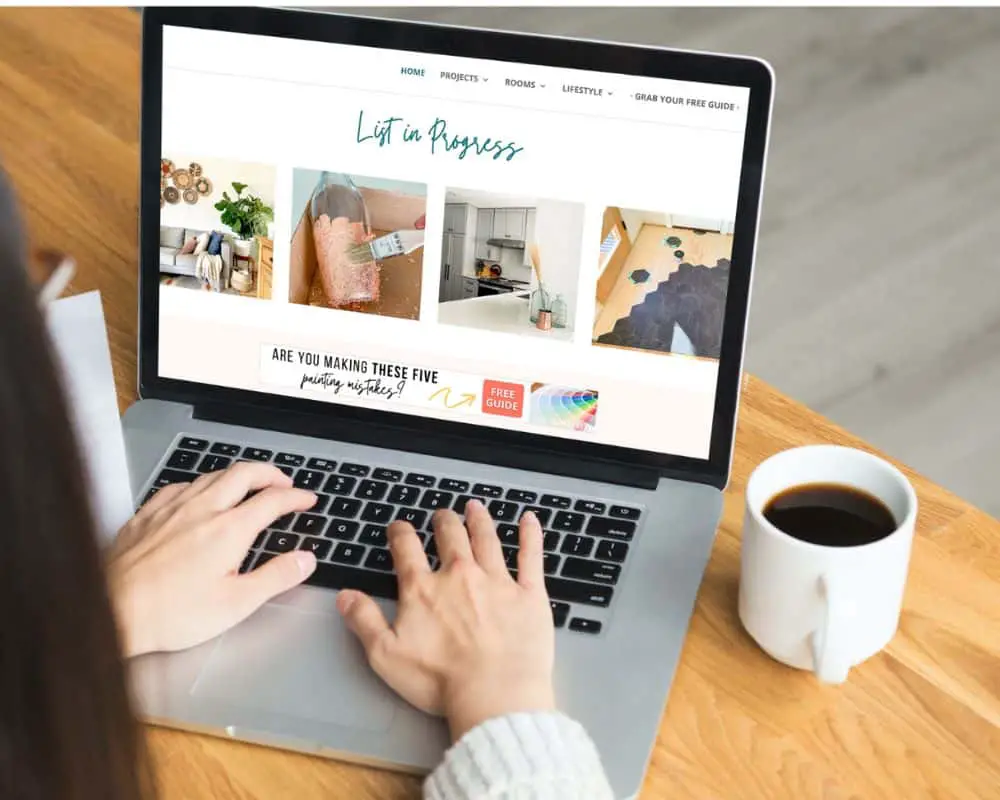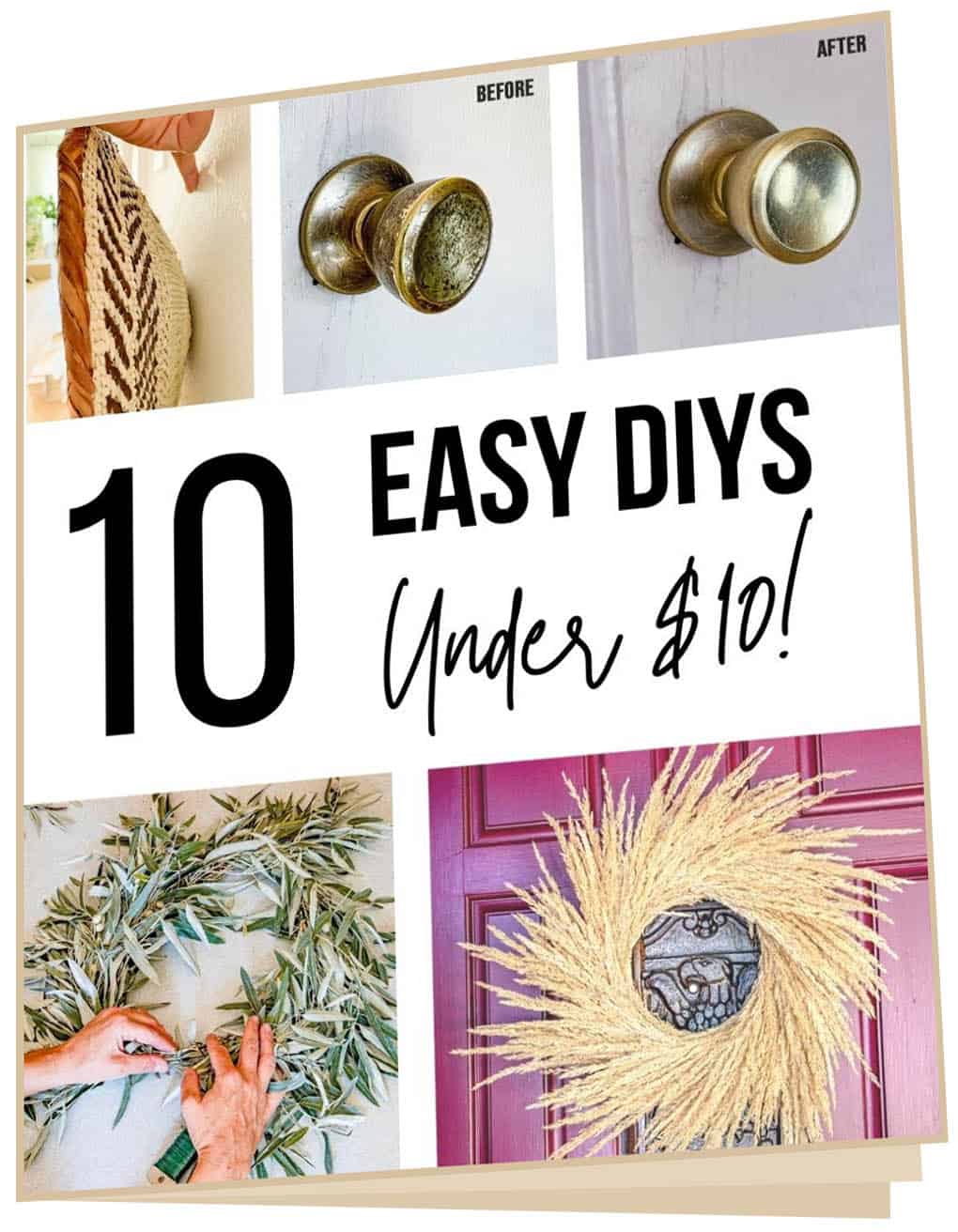Can I really recommend the best flooring product for EVERY room? (Got your attention, right?) Of course I don’t have all the answers, but I do have a lot of experience with flooring. Any so many opinions to share! This is a beast of a post, but I hope it’s a useful resource as you research flooring.
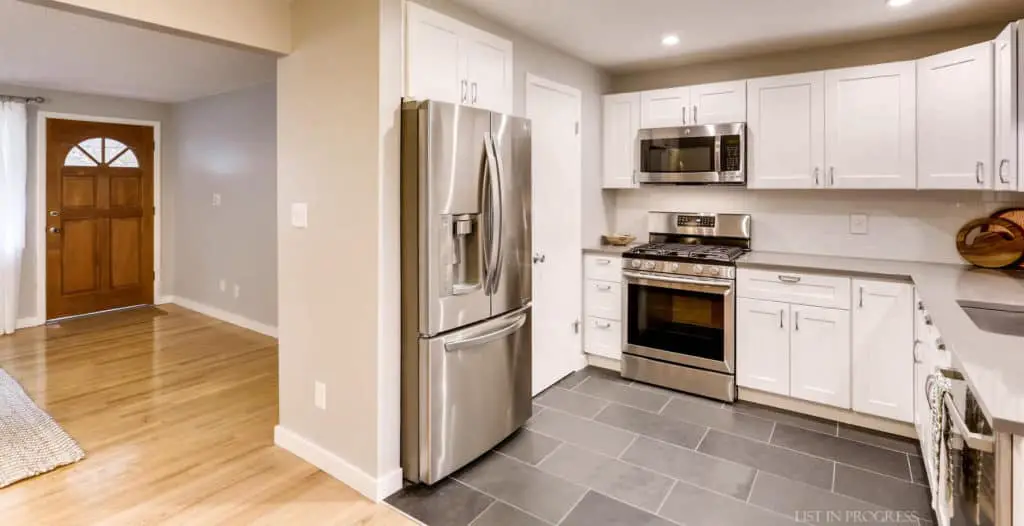
Choosing the Best Flooring For YOUR Home
There are so many factors to consider when choosing flooring. It can be a daunting task to narrow the field. Outside of personal preference for color and style, there are some basic elements to consider before picking the “best flooring” for your space. I’ve listed pros and cons for each of my recommendations based on the following factors:
- Cost – low-mid price range/mid-high price range
- Durability – How will it hold up to foot and pet traffic?
- Comfort – How does it feel compared to other flooring?
- Water resistance – Can it be used in wet areas vs. dry?
- Maintenance – What are the cleaning or other maintenance requirements?
- Installation – How easy/difficult is the product to install? (for a novice DIYer)
Flooring For Entries, Mudrooms, and Bathrooms
Let’s start with the flooring where you enter your house. Most likely, you’ll want something waterproof, unless you live in Arizona. I’ve lived in houses with wood floors up to the front door and they will get damaged unless you are very careful to protect them. If you’re starting from scratch, isn’t it easier to just go with something waterproof? Obviously, the same goes for bathrooms, mudrooms, etc. Here are some choices you might consider.
How to Install Groutable Vinyl Floor Tile
Read More About Our DIY Home Updates
Favorite Behr White Paint Colors
Closet Door Ideas to Update Any Room
Easy DIY Wax Melts to Make Your Home Smell Great
Trends in Cabinet Hardware
Porcelain tile – A solid choice for flooring, anywhere. <- get it? Porcelain is more durable and waterproof than ceramic, and therefore, more expensive. You can DIY this project, but know in advance that it can be very time-consuming. It also requires some attention to detail and a wet saw. Like ceramic, you’ll have to stay off the floor during installation, which can be inconvenient. However, porcelain tile is easy to maintain and clean, as well as more scratch-resistant than natural stone. It’s a very versatile option for many spaces.
Cost: mid-high price range
Pros: durability, water-resistance, easy maintenance
Cons: installation, comfort
Here are three fabulous bathrooms with porcelain tile in different patterns, styles, and textures!
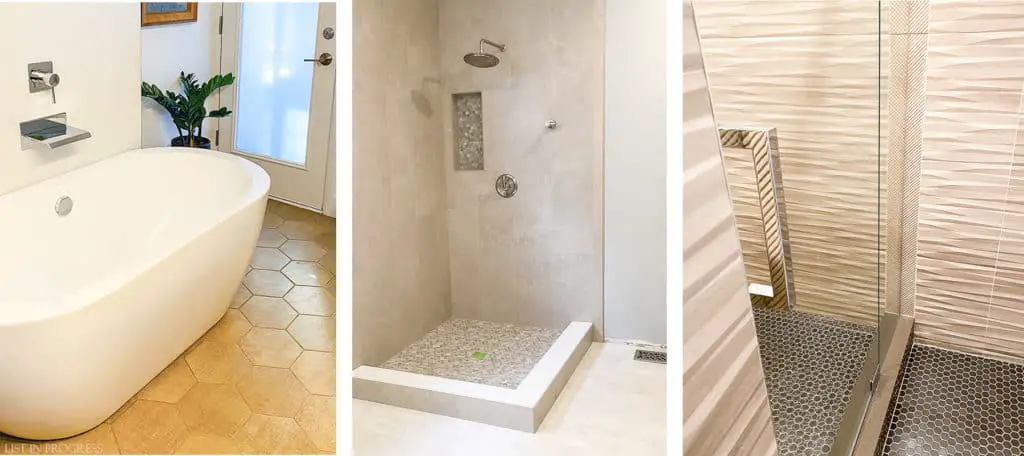
Ceramic tile – More affordable than porcelain tile, but not as durable. Water-resistant and easy to clean, but it takes a few days to install, when you’ll have to stay off the floor. Just like porcelain. It’s a great choice for kitchen backsplash though! If you’re debating between ceramic and porcelain, here is a thorough article comparing the two.
Cost: low-mid price range
Pros: water resistance, easy maintenance
Cons: installation, durability, comfort

Slate tile/natural stone – Perhaps the most beautiful choice for tile flooring, natural stone is hard to top in looks. That explains why marble bathroom floors are all the rage right now! Real slate, marble, granite, and travertine are the most popular options and some can be used indoors or out. Stone ranges from water-resistant to waterproof, but it requires some maintenance and care to avoid scratches and stains. You’ll have to research your particular choice of natural stone to determine if its properties are a good fit with your space. It’s also a fairly expensive choice.
Cost: mid-high price range
Pros: water resistance, some durability
Cons: installation, maintenance, comfort
Luxury Vinyl – This product is upgraded vinyl and you’ll find two forms, luxury vinyl tile (LVT) and luxury vinyl plank (LVP). Like the names imply, LVT often looks like stone tile, and LVP often resembles wood planks. Both are typically textured on the surface to more closely resemble the products they imitate. Luxury vinyl is a solid water-resistant option for wet spaces and has a warmer feel than stone or tile. It’s affordable, easy to install, extremely durable, and easy to maintain and clean – so many advantages! My friend Kristin installed this luxury vinyl tile (below) in her laundry room and basement, and it adds great texture and aesthetic appeal to her space!
Cost: low-mid price range
Pros: water resistance, durability, installation, maintenance, comfort
Cons: It’s not marble? Seriously, I can’t think of one…
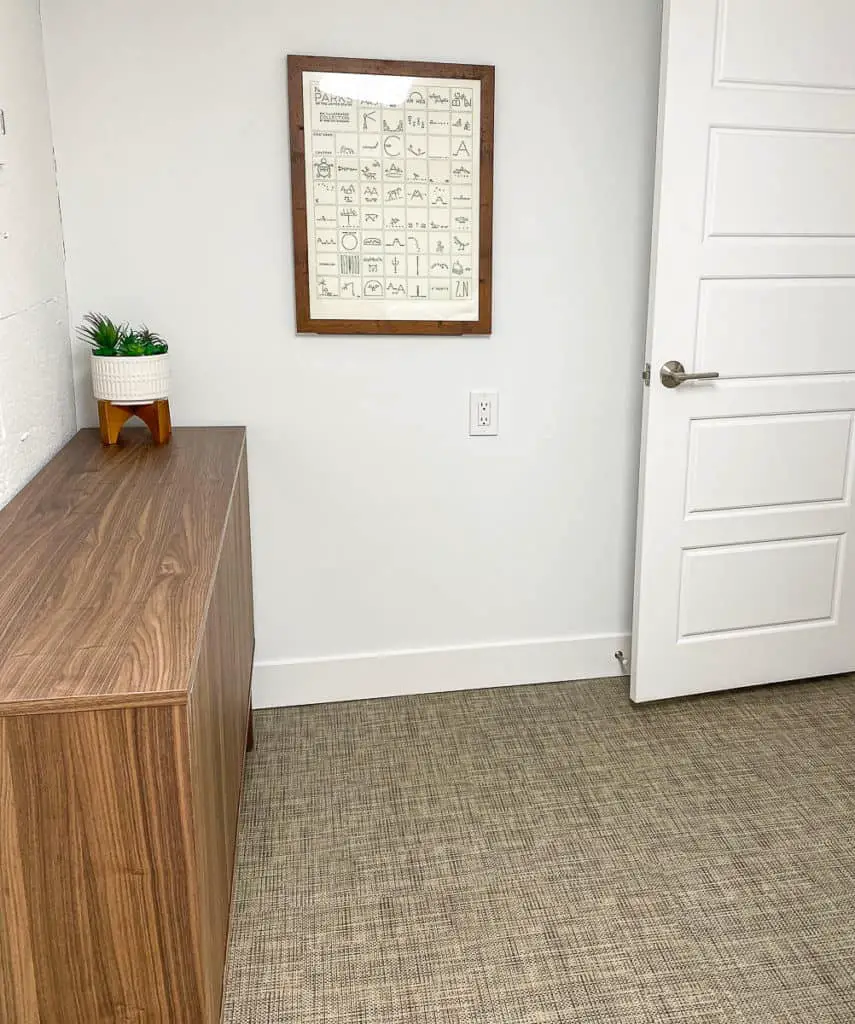
Groutable Vinyl Tile – Similar to luxury vinyl, there is another new(ish) vinyl option in stores – groutable vinyl tile. The grout helps the vinyl look similar to regular tile, although it’s much more affordable and easier to install. You don’t even need to grout it, in truth. Each tile is basically a sticker, so just peel off the backing and stick it down on a prepped surface. Then rent a 100 lb roller from a big box hardware store and roll it over the floor before applying grout. Done! We installed these groutable vinyl planks in both bathrooms of our first house and were thrilled with the result. Here’s our tutorial on how to install it!
Cost: low-mid price range
Pros: water resistance, durability, installation, maintenance, comfort
Cons: Perhaps not as stylish as tile or natural stone?
How to Install Groutable Vinyl Floor Tile
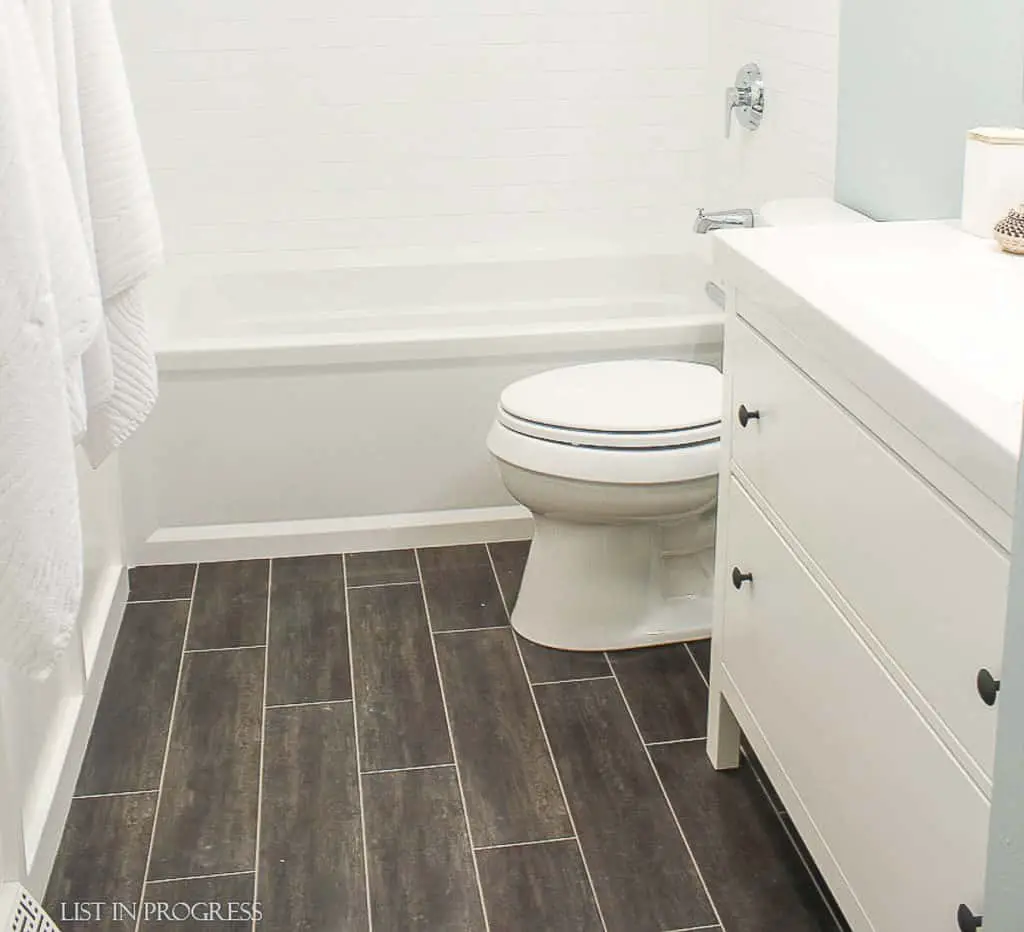
The Best Flooring Products For Kitchens
Kitchens are a gray area in terms of waterproofing. Are you willing to maintain a more delicate floor? Does your floor stay fairly dry? If so, then you have a few more choices. Natural stone, porcelain, luxury vinyl, and groutable vinyl are all great kitchen choices in terms of water resistance and cleaning ease. However, consider that kitchens get a lot of traffic, so durability is an important factor. We installed a beautiful slate floor in our first house, but then nervously crossed our fingers that our kids and dog wouldn’t scratch it. Spoiler alert: they did. Now we have porcelain tile.
Here is our previous kitchen with this slate tile:
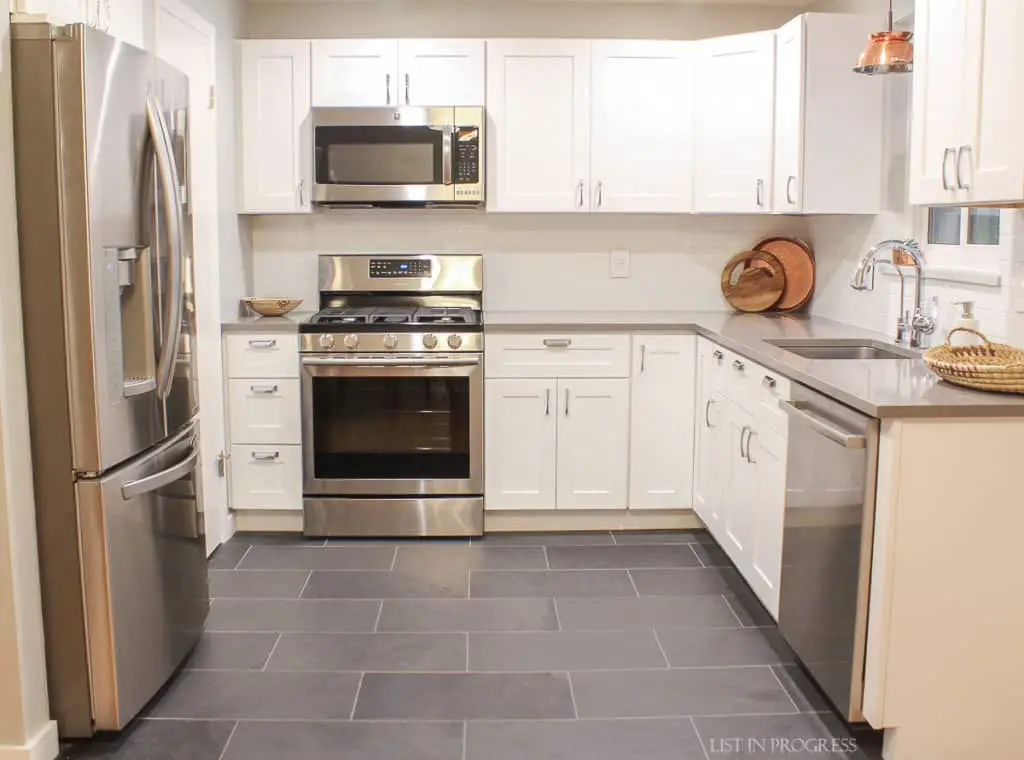
If you’re looking for durability, porcelain is the go-to tile choice. Here is our current kitchen, below, with charcoal porcelain tile in a herringbone pattern for visual interest. (I swear I’m not hooked on slate, but once I found this similar porcelain tile, I had to try it!) Our current kitchen is still a remodel-in-progress:

Added to the list of choices…
Brick – I’ve started seeing brick come back into kitchens, and personally, I like its rustic warmth. If you’re looking for a natural material that won’t off-gas like vinyl or other manufactured floor products, this is it. As for cost, it should be comparable to a read hardwood floor, with a mid-range price point. You will have to seal it to prevent spills and stains; brick is porous, like natural stone, due to its mineral content. It’s also obviously hard and durable, which is great for lifespan but could be uncomfortable for the home chef who spends hours in the kitchen. As for installation, I would compare it to tile, so if you’re comfortable with that moderately-tricky DIY project, why not tackle brick?
Cost: mid-high price range
Pros: durability, maintenance, water-resistance
Cons: installation, comfort
Read More About Our DIY Home Updates
Favorite Behr White Paint Colors
Closet Door Ideas to Update Any Room
Easy DIY Wax Melts to Make Your Home Smell Great
Trends in Cabinet Hardware
Flooring in Living Rooms, Family Rooms, and Bedrooms
These living spaces are the most flexible for flooring choices. It’s really just personal preference here. You might love the beauty of a real hardwood floor or wish for a cozy wall-to-wall carpet. When I have the choice, I pick hardwoods in the main living areas, with rugs for floor protection, comfort, and decor. These are great choices:
Wood – Real wood floors are gorgeous. Can anyone debate that? Just be sure to keep those boards dry and clean. Hardwoods add warmth and texture to any space, and they have a long lifespan if cared for properly. Since they scratch and dent easily, I wouldn’t call them durable, even though they can outlive engineered hardwoods. (Here’s a great comparison.) Real hardwood floors can be refinished about 4-10 times, based on how heavily they are sanded, and you can change the look easily with stain. Depending on which type and where you buy them, the cost is not crazy for some hardwoods. You can also install them yourself – just invest in a nailgun!
Cost: mid-high price range
Pros: maintenance, comfort
Cons: water resistance, durability, installation
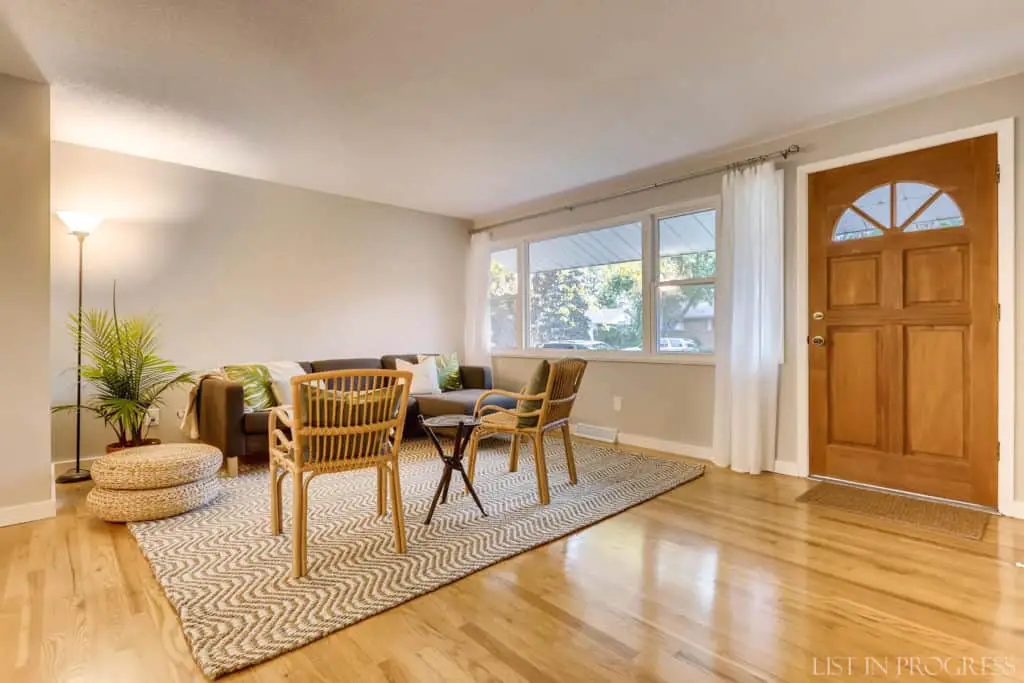
Engineered hardwood – This is a popular category these days because you can get the beauty of real wood with easier installation options. The boards are sold pre-finished, so no staining or sealing is needed after installation. Engineered hardwood is a thin layer of real wood glued to a piece of plywood. This actually makes it more water-resilient than real wood, although it doesn’t have the lifespan of a traditional hardwood floor. It can possibly be sanded once or twice to refinish, but that’s a gamble since the wood layer is thin. So, just be careful. Also, if you want to run wood floors in your kitchen or basement, engineered hardwood is a better bet than real hardwood.
Cost: mid-price range
Pros: installation, comfort
Cons: water resistance, maintenance, durability
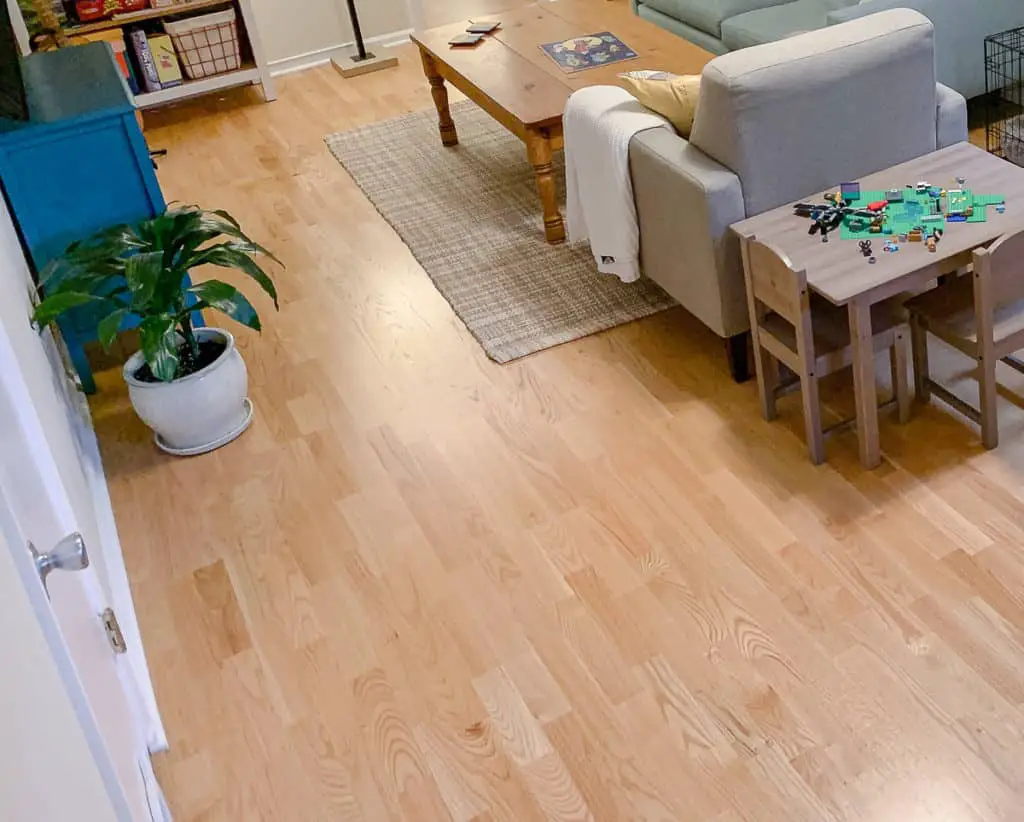
Laminate – Easy to install and super durable, laminate floors hold up great to kids and pets. If you want the look of hardwood but in a tougher, synthetic product, this is an affordable choice. Laminate is basically particle board (sawdust and glue) with a sticker on top that looks like real wood. The only drawbacks to laminate planks are that you’ll have to avoid any water damage and they can be difficult to repair. We had Pergo floors in our Seattle condo, and they still looked great after 6 years of living with an 80 lb dog. However, we had to replace the entire floor after a small flood warped the boards in the hallway.
Cost: low-mid price range
Pros: durability, installation, maintenance, comfort
Cons: water resistance
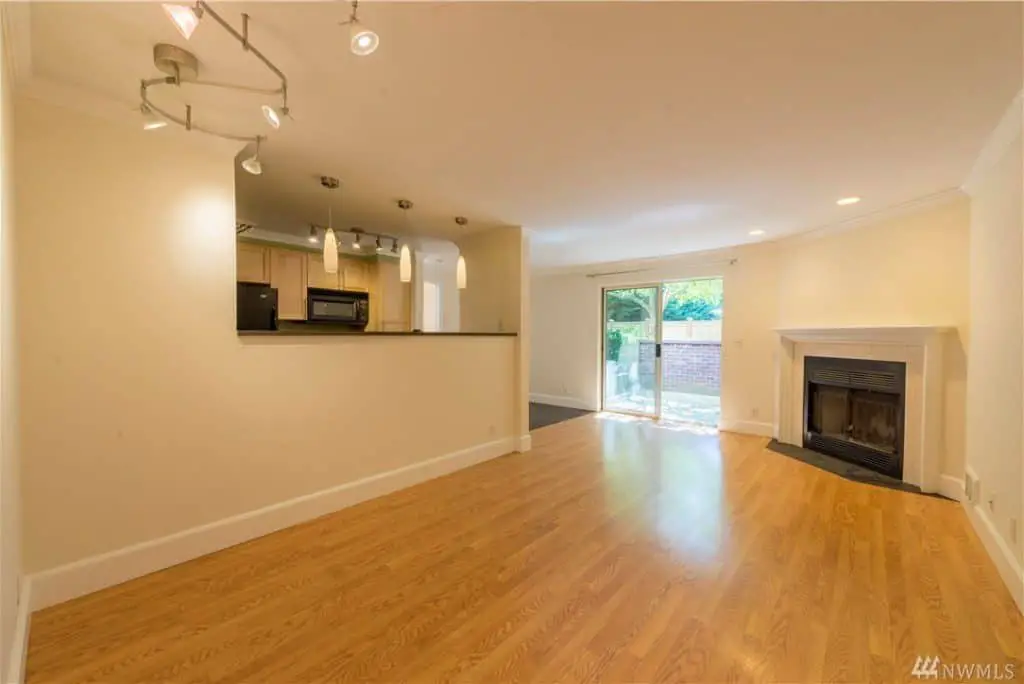
Cork – I can’t wait to find our forever home and install cork flooring in the family room. It makes for such a comfortable floor! Cork is another great eco-friendly choice and has thermal properties that maintain room temperature warmth. How cool is that? Durable in high-traffic areas and easy to maintain, there are few downsides to cork. Just be careful not to damage it with sharp furniture feet or animal nails. This is one of the pricier flooring options, so try to DIY the (supposedly) easy installation to save on cost.
Cost: mid-high price range
Pros: comfort, durability, installation, maintenance, water-resistance
Cons: durability (perhaps?)
Luxury Vinyl – see Entries, Mudrooms, and Bathrooms, above
Bamboo – Like brick and wood, if you’re looking for a natural material, bamboo could be a great choice. It’s a renewable resource, grows much faster than trees, and the traits of bamboo flooring are comparable to hardwood. Bamboo is fairly soft, which makes it comfortable to stand and walk on. I’ve read that it’s as durable as hardwood, but I swear it scratches much more easily. That’s just based on personal experience living with it at a rental house a few years ago.
Cost: mid-high price range
Pros: maintenance, comfort
Cons: water resistance, durability, installation
(This photo totally cracks me up. I originally took it for the “one shoe” look. Now it turns out to be the only photo I have of our old bamboo floors. Scratches and all!)
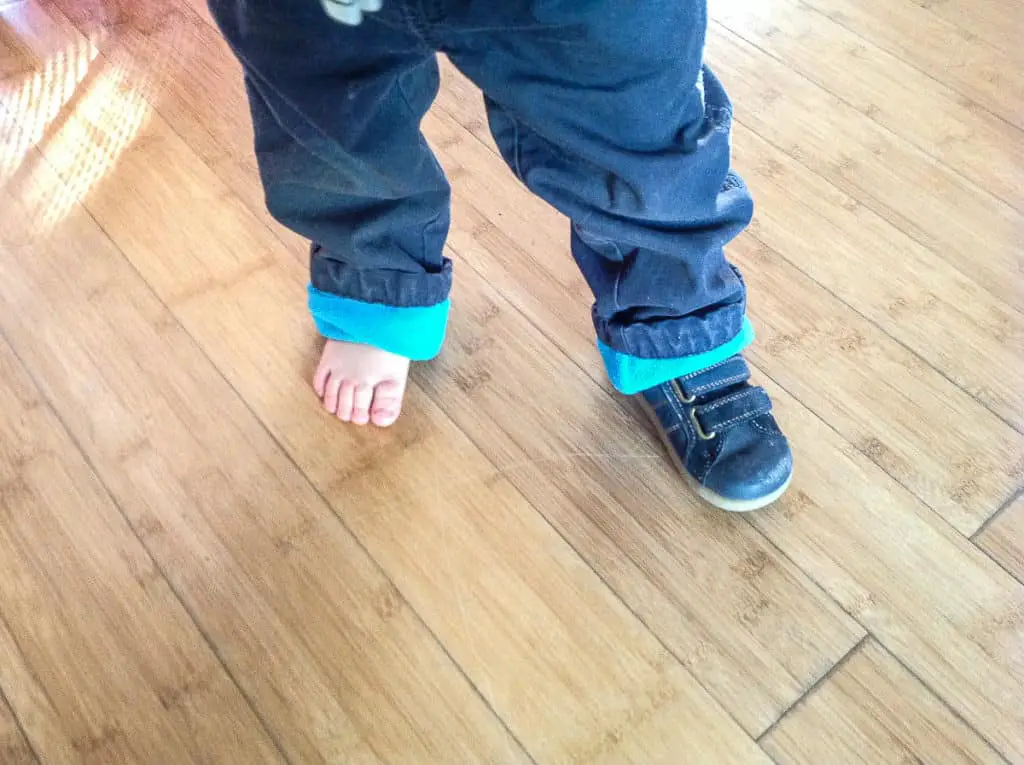
Carpet – Not much to say about carpet that you don’t already know! The comfiest flooring choice by far. I would suggest splurging on the carpet pad, even if you don’t splurge on the carpet itself. That can make a huge difference in comfort and carpet lifespan. Carpet cost runs from low to high end, so you can always find a product that fits your budget. My favorite carpet retailer in Denver is actually a warehouse that sells premium carpet at a discount, due to minor irregularities – nothing you would notice unless you’re in the carpet industry. Such a deal! Last note, carpet is hard to install properly as a DIY project, so this is one type of flooring we always hire out.
Cost: low-mid price range
Pros: comfort, durability, maintenance
Cons: water resistance, installation
Read More About Our DIY Home Updates
Favorite Behr White Paint Colors
Closet Door Ideas to Update Any Room
Easy DIY Wax Melts to Make Your Home Smell Great
Trends in Cabinet Hardware
What About the Basement?
Basements are tricky. While plush carpet makes a potentially cold and damp space much cozier… how likely are you to deal with water damage? You should consider that first. We just cleaned up a minor flood from our basement drain (ironically caused by carpet cleaning across the street), and I’m so thankful that the drain is surrounded by old linoleum in our basement. Otherwise, I would be supervising carpet replacement right now! Yuck.
Because basements are already dark and cool, and sometimes damp, it’s worth considering how you’ll use the space. You could choose a durable and waterproof option like tile, stone, or concrete. However, those are also cold, hard surfaces, and not exactly comfortable on bare feet. If you spend time relaxing in the basement, then carpet is certainly the most comfortable option. This can also be a great place for engineered hardwood, vinyl, or cork, since all are a bit softer and warmer than other water-resistant choices. Considering all this, my top picks for a basement are carpet or engineered hardwood (in dry areas), vinyl, cork, tile, or concrete.
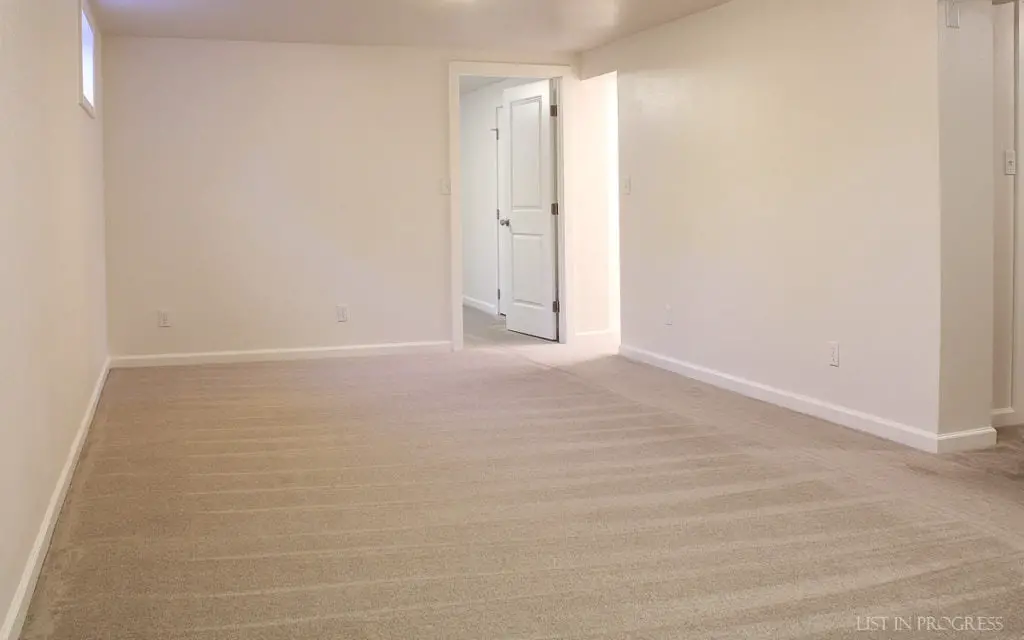
Concrete is one type of flooring that I haven’t yet covered. While it can technically work in almost any room in your house, it is only practical to install over an existing slab. That limits installation to the basement, unless your house is on-grade. Here’s the overview:
Concrete – Believe it or not, you can unleash your inner artist with concrete and stain it in different colors. How cool! Once it’s sealed, concrete makes for a very durable, low-maintenance floor. Obviously, it’s not the most comfortable of flooring options, but if it’s resealed twice a year, proper maintenance will help a concrete floor last for decades. You can even cover it with a different type of flooring in the future, if you change your mind down the road. The cost ranges from low to high end and installation is not DIY.
Cost: mid-high price range
Pros: durability, maintenance, water resistance
Cons: comfort, installation
That’s it for now! Did you decide on the best flooring for your house? Would you like me to add anything to this list? Let me know in the comments!
More Decor + DIY Inspo From List in Progress

1 – Easy DIY Wax Melts to Make Your Home Smell Great
2 – Affordable (and Free!) Ideas for Fall Decor
3 – My Favorite Affordable Turkish Towels
4 – A “Work in Progress” Home Tour


